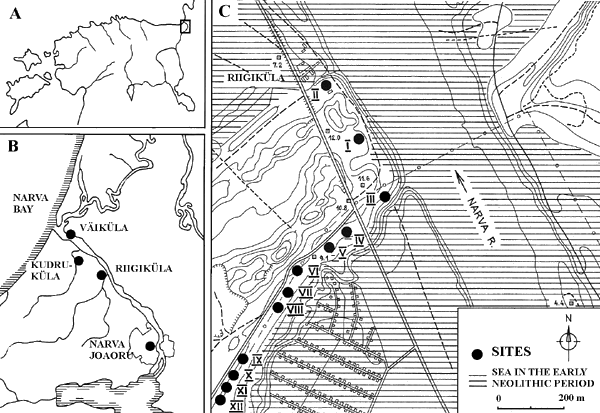FORMATION AND DEVELOPMENT OF THE STONE AGE SETTLEMENT
AT RIIGIKÜLA, NORTHEASTERN ESTONIA
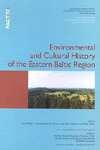
Aivar Kriiska Published: Environmental and Cultul History of the Eastern Baltic
Region. PACT 57. Rixensart 1999, 173–183.
Abstract
Keywords: Neolithic, Narva
culture, Combed Ware culture, Late Corded Ware culture.
THE BEGINNING OF SETTLEMENT. THE NARVA CULTURE The Riigiküla
settlements are
situated about 8 km northwest of the town of Narva, on the coastal lowland
behind the north Estonian Klint, on a NE-SW oriented ridge (Fig. 1). The
area borders on the Narva River in the northeast and the Tõrvajõgi
brook in the southeast. The geological setting of the area is not yet quite
clear, but it was evidently a spit reaching out into the sea and forming
a lagoon behind it into which the Narva and Luuga rivers flowed. The bottom
sediment of the lagoon consists of diatomite, mostly containing freshwater
diatoms (Thomson, 1937, p. 214–215). Referring to Paul William
Thomson, Richard Indreko connected this ridge with the coastal formations
of the Ancylus Lake and Litorina Sea (Indreko, 1932, p. 50; 1948, p. 94).
Thomson (1937, p. 215) proposed that it may also be connected with an end
moraine which was penetrated by the Narva River before and also after the
Ancylus Lake transgression. According to Lissitsyna (1961, p. 540), the
ridge must have been formed during the Litorina Sea transgression (Kessel
and Raukas, 1967).
Regardless of the genesis
of the formation, the initiation of settlement at Riigiküla has been connected
with the existence of a spit projecting into the Litorina Sea. The earliest
traces of habitation represent the Early Neolithic Narva culture and cover
a 2 km strip on the northeastern and southeastern slopes of the ridge (Fig.
1C). A total of 13 sites can be distinguished on the basis of the concentrations
of finds, the majority situated on the lagoonal coast of the spit. The
locations of sites I to III may indicate that the watershed was located
where the Narva River is today.
Several fire-pits have
been found that date back to the period of the Narva Culture. A 2 x 1 m stone fire-pit
was found at site III that had been dug down 20 cm into the sand surface
(Gurina, 1967, p. 12), and three fire-pits were investigated at site IV,
although only one of them to its full extent. All of these had been hollowed
out to 25–40 cm below the sand surface, two were without stones
and the remaining one had just a few stones. The fire-pit which was excavated
completely was oval in shape, with dimensions of 2.5 x 1.5 m (Kriiska,
1996a).
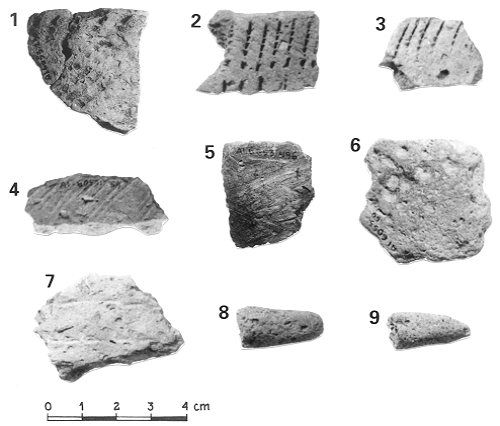 Fig. 2. Pottery of the Narva type from Riigiküla, site IV (AI 6053 : 230, 127, 67, 59, 496, 60, 92, 138, 435). The majority of the finds are potsherds. The pottery had mostly been tempered with some vegetable material which had then been destroyed on burning, or with clay mixed with mollusc shells. The sharp-bottomed conical vessels had been fashioned by the band technique, quite often out of bands only 10 mm wide with U-shaped connecting surfaces, one of the contact surfaces of the coil being convex and the other concave. The surfaces are often scratched (Fig. 2 : 2; 4–5). Decorative motifs such as comb impressions (Fig. 2 : 1–3), notches, hollows (Fig. 2 : 6), grooves (Fig. 2 : 7) and others are rare, so that only 5% of the potsherds at site IV, for example, had been decorated (Kriiska, 1996a). In addition to the sherds, small clay bars have been found at Riigiküla, of a composition similar to the Narva-type pottery (Fig. 2 : 8–9), so that they could be regarded as production residue — the ends of rolls shaped for making clay bands (Kriiska, 1995a, p. 74), although other interpretations have been put forward as well (Gurina, 1955, p. 168; 1967, p. 40). 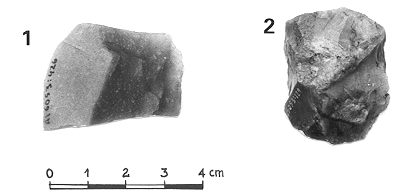 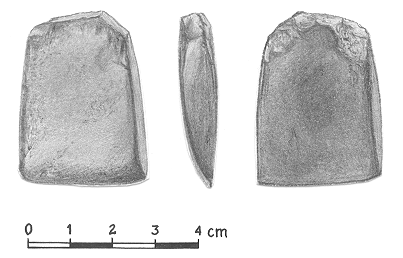 As most of the sites investigated so far have yielded multicultural finds, differentiation of the material is complicated. Some tendencies can nevertheless be extracted. Relatively little use is made of stone, as flint and quartz were the most frequent materials, fragments of other rocks and some smaller tools — mainly scrapers — being less common (Fig. 3). Some stone chisels are certainly connected with the Narva culture, and one such item has been found in a trial pit at site XII, together with Narva pottery. This has been radiocarbon dated using charcoal from a cultural layer in the same place (Fig. 4; Table 1). Antler and bone tools have also been found : harpoon tips (Fig. 5 : 1), points made of hollow bone (Fig. 5 : 2), including a bone with an edge cut at an angle of 45°, which is considered one of the leading forms in the Narva culture (Jaanits, 1968, p. 19; Loze, 1988, p. 26), awls, wedges etc. (Gurina, 1967; Kriiska, 1996a). 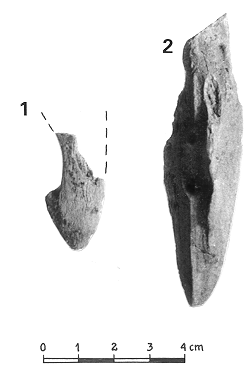 The settlement at
Riigiküla
was based on a hunting and gathering economy. The osteological material
includes numerous fish and bird bones, and the seal played an important
role among the mammals, although the main terrestrial animals were evidently
also caught (see Lõugas, this volume, Chapter I.9). Marten bones were
surprisingly
numerous amongst the osteological material at site IV (35% of the mammal
bones), which may be indicative of intensive hunting of fur-bearing animals
in winter (Tanel Moora, oral communication).
It is still difficult to judge how
permanent the settlement was. The ecological edge-effect which must have
prevailed at such a place where the distribution areas of animal populations
intersected, provided conditions under which the population of Riigiküla
could cope throughout the year. The wide variety of species represented
in the osteological material indicates permanent rather than seasonal habitation.
The occurrence of occupational layers over a fairly wide area suggests
mobility in this settlement unit, and even periodic break-ups cannot be
excluded.
Four radiocarbon dates referring
to the period 6023±95 to 5268±58 BP (Table 1), i.e.
connected with the Narva Culture, have been obtained from Riigiküla
up to now. TABLE 1. RADIOCARBON DATES FROM RIIGIKÜLA AND KUDRUKÜLA.
CHANGES IN THE SETTLEMENT PATTERN. COMBED WARE CULTURE The continuous process of land uplift caused the sea to retreat from Riigiküla, and the lagoon became overgrown. This inevitably influenced human settlement, too. At the present state of investigation, it is not possible to date the changes in either the environment or human habitation very precisely, but the locations of the sites of the Typical Combed Ware culture suggest that this shift had already taken place by that time. The Combed Ware reported up to now and the other finds of that period have been concentrated in the northeastern part of the ridge, at the sites located closer to the Narva River (Fig. 1). Typical and Late Combed Ware make up 73% of the Neolithic pottery at site I, 98% at site II and 17% at site III (Table 2). At the same time, the southeastern part of the ridge, the previous lagoon coast has almost only finds of the Narva culture. Among the Neolithic pottery at site IV, only 0.3% is Combed Ware (5 sherds), even though sieving proceeded through the entire occupation layer during the excavation at this site, unlike the others. Three out of 148 potsherds gathered from the trial pits at sites V–XII (2%) represent Typical Combed Ware (partly published by Kriiska 1995b, p. 453), and these should probably be treated in the same way as the sites established on the river bank not far from the estuary. Chronologically, they lie between the latest date for the Narva culture at Riigiküla and the earliest date for the Late Combed Ware culture in Kudruküla, i.e. 5268±58 to 4860±60 BP (Table 1). TABLE 2. TYPOLOGICAL DIVISION OF NEOLITHIC POTSHERDS FOUND IN EXCAVATIONS AT THE RIIGIKÜLA SITES (GURINA, 1967; KRIISKA, 1995a; 1996a).
The most exciting
complexes of Riigiküla
connected with the period discussed here are the bottoms of buildings with
inhumation burials dug down below the surface at site I. As the latter
have quite often been published, they will not be discussed in any more
detail here (see Gurina, 1967; Jaanits et al., 1982; Kriiska,
1996b). A stone fire-pit 1.5 m in diameter extending 50 cm into the sand
surface has also been investigated at site II (Gurina, 1967, p. 16).
The majority of the finds are potsherds.
The Typical Combed Ware has been made with a mineral addition, mostly stone
rubble mixed with clay, and the remains are of quite large, thick-walled,
conical, round-bottomed vessels decorated with comb impressions, hollows
and pits. The decoration covers the vessel surfaces in zones, with alternating
lines of comb impressions and pits or hollows. The sherds representing
Late Combed Ware at Riigiküla belong to the first, earlier chronological
group. The composition of the clay used for making the vessels changed,
the stone rubble being replaced by organic matter, vegetable material or
cracked mollusc shells, but the decoration still corresponds to the canons
of the Typical Combed Ware (Kriiska, 1995a).
Among the other finds, the Combed
Ware culture can most easily be connected with artefacts made of imported
flint, because with only a few exceptions, the use of flint in the Narva
Culture was based on local raw material of low quality. In addition to
scrapers and burins, there are many arrowheads and spearheads, mainly sharp
and oval in shape or diamond-shaped (Gurina, 1967), as throughout the area
of the Combed Ware culture (Edgren, 1984, p. 68; Loze, 1984, p. 30). Stone
chisels have also been found, including a claw-shaped chisel, a form which
did not exist in Estonia before the Typical Combed Ware culture (Jaanits
et al., 1982, p.70).
The animal bones point to changes
in the hunting and gathering economy. The decline in the importance of
sealing can be seen in the percentage of bones of these creatures, while
the hunting of wild boar became more important (see Lõugas, this
volume, Chapter I.9). These effects were probably brought about by a change
in the natural environment. The swamped lagoon and surrounding damp forest
provided a suitable environment for wild boars, as is also the case today
(Aul et al., 1957, p. 284). The variety of bones and artefacts
is not indicative of seasonal habitation in Riigiküla in the time
of Combed Ware culture.
The people evidently left the area
of Riigiküla later, probably following the retreat of the sea, as
may be concluded from the existence of the sites of Kudruküla and
Väiküla some kilometres to the northwest (Fig. 1). The majority
of finds from these two sites belong to the younger chronological group
of the Late Combed Ware, which has a different decoration as well as being
produced from a clay of a different composition (Kriiska, 1995a, p.
93–94).
Radiocarbon dates of 4860±60 and 4750±100 BP have been
obtained for the Kudruküla site (Table 1).
The quite rich bone material gathered
from the Kudruküla site comprises both human and animal bones. The
latter point to the important role of sealing alongside the hunting of
terrestrial animals and fishing. At the same time the frequency of seal
bones is twice as high as at the Riigiküla sites or even more. The
majority of the seal bones were of the harp seal (Lõugas, 1993,
p. 83). RESETTLEMENT. LATE CORDED WARE CULTURE A new phase in settlement
at Riigiküla
is connected with the Late Corded Ware culture. Radiocarbon dates are still
lacking, but the typology of the artefacts, the stratigraphy and the location
of the sites in the landscape all suggest that this stage belongs to the
end of the Neolithic period and the beginning of the Bronze Age (Jaanits
et al., 1982, p. 109, 130; Jaanits, 1992, p. 51–
52). Late Corded Ware has been found in the same area as the traces of
earlier settlement, as a by-product of the investigations at sites I, II
and IV at Riigiküla (Table 2). Only site XIV is a "proper" one, where
trial pits yielded only Late Corded Ware sherds. Unfortunately this site
has not been excavated. Another site on the lower reaches of the Narva
River where potsherds of the same type have also been found is Narva Joaoru
(Kriiska, 1995a, p. 95). No other finds can be connected with this culture,
although the Corded Ware sherds of are stratigraphically distinct, occurring
in the uppermost part of the cultural layer at the Riigiküla IV site,
for instance. This is of course the layer mixed most by ploughing.
The potsherds come from vessels with
a small flat bottom that widen out in the upper part (Fig. 6, 2–3).
The decoration, with its cord impressions (Fig. 6, 1), grooves and notches,
can be seen mostly in the upper part of the vessels but the surfaces are
often striated (Jaanits, 1954, p. 358; Kriiska, 1995a, p. 99, 104; 1996).
Fine curved line imprints on the surfaces of vessels are peculiar to the
Late Corded Ware found in Riigiküla and other places in Estonia (Jaanits,
1959, p. 152; Kriiska, 1995a, p. 100) (Fig. 6, 4–9), and these
together with small round holes inside the sherds indicate that a lot of
hair was mixed into the temper.
The settlement
pattern which developed at that time differed from the previous one. Sites were
established on a high sandy ridge several kilometres from the sea, bordering on the
Narva River in the northeast and the Tõrvajõgi brook in the
southeast. Changes in the subsistence pattern can be assumed to have taken
place, and the needs of the farming economy were evidently taken into
consideration when choosing the place for habitation. The farming economy was probably
something closer to a mixed economy in this context. The increase in the
number of cultural graminaceous (grass) plants in the pollen diagrams
indicates quite active cultivation of the land in Estonia (Moe et al.,
1992; Lang, 1995, p. 136), but the scarcity of finds in the cultural layers
suggests only a short duration for the habitation period and fairly small
human groups, particularly by comparison with those that subsisted on
hunting and gathering. 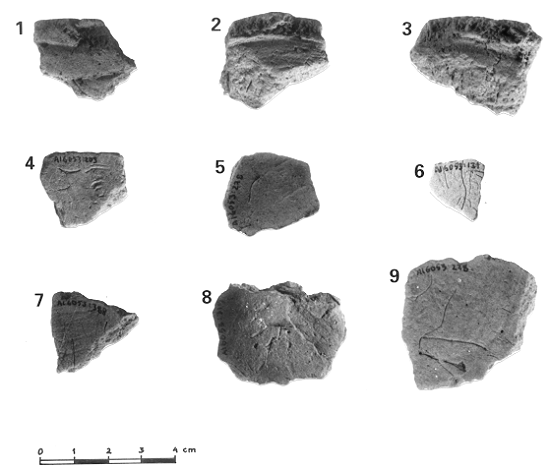 Fig. 6. Late Corded Ware pottery from Riigiküla, site IV (AI 6053:200, 388, 258, 203, 278, 131, 388, 319, 278). CONCLUSIONS In this way Riigiküla gained its first inhabitants at the beginning of the Neolithic period, when people of the Narva culture settled on the spit-side shore of the lagoon. After clogging of the lagoon, the settlement moved from the ridges of Riigiküla and Tõrvala to the banks of the Narva River, a process that took place before the time when the Comb Ware culture settlement was formed. The settlement moved later following the regression of the sea, and no new sites were established in the area of Riigiküla itself, which was unsuitable for a hunting and gathering economy. It was only at the end of the Neolithic period or the beginning of the Bronze Age that a settlement representing the Late Corded Ware culture and evidently based on a farming economy formed on the ridge bordering on the rivers. Aivar
KRIISKA
Department of Archaeology Tartu University Ülikooli 18 EE-51003 TARTU, Estonia REFERENCES AUL, J.,
LING, H. and PAAVER, K., 1957, Eesti NSV imetajad (The mammals of
Estonian SSR) Tallinn, 351 p. (in Estonian).
EDGREN, T., 1984, Kivikausi (The Stone Age), in T.
EDGREN, U. SALO and P.–L. LEHTOSALO-HEILANDER
(eds), Suomen historia, 1, Weilin and Göös, Espoo,
p.18–85 (in Finnish).
GURINA, N. N.,1955, Novyje neolititsheskie pamjatniki v
Vostotshnoi Estonii (New Neolithic Monuments in Eastern Estonia), in
Muistsed asulad ja linnused,
Arheoloogiline kogumik, I, Tallinn, p. 153–175 (in
Russian).
GURINA, N. N., 1967, Iz istorii drevnih plemen zapadnyh
oblastei SSSR (On the history from the western regions of USSR), in
Materialy i issledovanija po
arheologii SSSR, 144, Leningrad, Nauka, 208 p. (in
Russian).
INDREKO, R., 1932, Kiviaja võrgujäänuste
leid Narvas (Stone
Age find of fishing net remnants), in Eesti Rahva Muuseumi
Aastaraamat
VII 1931, Tartu, p. 48–67 (in Estonian).
INDREKO, R., 1948, Die mittlere Steinzeit in Estland, Mit
einer Übersicht die Geologie des Kunda-Sees von K. ORVIKU, in
Kungliga Vitterhets Historie och Antikvitets Akademiens
Handlingar, 66, Stockholm, 428 p.
JAANITS, L., 1954, Neoliitilised ja varase metalliaja
asulad Emajõe suudmealad
(Neolithic and Early Metal Age settlements at river mouth of Emajõgi
River), in Eesti NSV Teaduste Akadeemia Toimetised, 3, p.
350–366 (in Estonian).
JAANITS, L. J., 1959, Poselenija epohi neolita i rannego
metalla v priustje p. Emaiygi,
Estonskaja SSR, (Siedlungsplätze des Neolithikums und der Frühen
Metallzeit im Mündungsgebiet des Emajõgi), Academy of Sciences
of the Estonian SSR, Institute of History, Tallinn, 382 p. (in Russian
with German summary).
JAANITS, L., 1968,
Die frühneolithische Kultur in Estland, in Congressus
Secundus Internationalis Fenno-Ugristarum Helsingiae habitus
23.–28. VII. 1965, Pars 2, Helsinki, p.12–25.
JAANITS, L., 1992, Põllumajanduse eelduste
kujunemine (Development of preconditions for agriculture), in Eesti
talurahva ajalugu, I, Eesti TA Ajaloo Instituut, Olion, Tallinna, p.
42–56 (in Estonian).
JAANITS, L., LAUL, S., LÕUGAS, V. and TÕNISSON,
E., 1982, Eesti esiajalugu
(Estonian Prehistory), ‘Eesti Raamat’, Tallinn, 462 p. (in Estoni).
KESSEL, H. and RAUKAS,
A., 1967, Priberezhnye otlozhenija Antsilovskogo ozera i Litorinskogo
morja v Estonii (The deposits of Ancylus Lake and Litorina Sea in
Estonia), ‘Valgus’, Tallinn, 134 p. (in Russian
KRIISKA, A., 1995a, Narva jõe alamjooksu ala
neoliitiline keraamika (The
Neolithic pottery from the area of the lower reaches of the River Narva),
in V. LANG (ed.), Eesti arheoloogia historiograafilisi, teoreetilisi
ja kultuuriajaloolisi aspekte, Muinasaja teadus, 3, Tallinn, p.
54–115. (in Estonian).
KRIISKA, A., 1995b, New Neolithic settlements in
Riigiküla, in Proceedings
of the Estonian Academy of Sciences, Humanities and Social Sciences.
44, 4, p. 448–454.
KRIISKA, A., 1996a,
Archaeological excavations in Neolithic site of Riigiküla IV,
in Proceedings of the Estonian Academy of Sciences, Humanities and
Social Sciences, 45:4, p. 410–419.
KRIISKA, A., 1996b,
The Stone Age Settlements in the Lower Reaches of the Narva River,
North-Eastern Estonia, in T. HACKENS, V. LANG, U. MILLER AND L.
SAARSE (eds.), Coastal Estonia: Recent Advances in Enviromental and
Cultural History, PACT, 51, Rixensart, p.
359–369.
LANG, V., 1995, Varane
maaviljelus ja maaviljelusühiskond Eestis: ääremärkusi
mõningate arengutendentside kohta (Early farming and farming
society in Estonia: comments on some tendencies of development), in V.
LANG (ed.), Eesti arheoloogia historiograafilisi, teoreetilisi ja
kultuuriajaloolisi aspekte, Muinasaja teadus, 3, Tallinn, p.
116–181. (in Estonian with English summary).
LISSITSYNA, G. N.,
1961, Voprosy paleogeografii neolita raionov severozapada Evropeiskoi
tshasti SSSR (Question of the Neolithic palaeogeography at northwestern
districts of the European part of the USSR), in Drevnjaja istorija
severozapada Evropeiskoi tshasti SSSR, Materialy i issledovanija po arheologii
SSSR, 87, Moskva–Leningrad, p. 535–578. (in
Russian).
LOZE, I. A., 1984,
Pamjatniki grebentshato-jamotshnoi keramiki v Vostotshni Pribaltike,
in Novoje v arheologii SSSR i Finljandii (Combed Ware monuments
in the East Baltic area), in B. A. RYBAKOV (ed.), Novoje v arheologii
SSSR i Finljandii, in Doklady Tretego sovetsko-finljandskogo
simpziuma po voprosam arheologii 11–15 maja 1981 g, Leningrad,
p. 28–34 (in Russian with German and Finnish summaries).
LOZE, I. A., 1988,
Poselenija kamennogo veka Lubanskoi niziny. Mezolit, rannii i srednii
neolit (The Stone Age Habitation Sites of the Lubana Lowland. Mesolithic,
Early and Middle Neolithic), Zinatne, Riga, 211 p. (in Russian with English
summry).
LÕUGAS, L.,
1993, Kui gröönihüljes elas Läänemeres
(When the Greenland seal was living in the Baltic Sea), in Eesti
Loodus, p. 83–84. (in Estonian).
MOE, D., KIHNO, K.
and PIRRUS, R., 1992, Anthropogenic Disturbance of Vegetation in
Estonia through the Holocene based on some selected Pollen Diagrams. A
Preliminary Survey, in HACKENS, T., LANG, V. and MILLER, U., (eds),
Estonia: Nature, Man and Cultural Heritage, PACT, 37, Rixensart,
p. 79–95.
THOMPSON, P. W., 1937,
Narva Diatomiit (Narva diatomite), in Eesti Loodus,
5, Tartu, p. 214–216. (in Estonian). |
